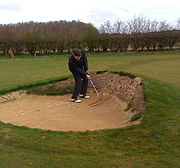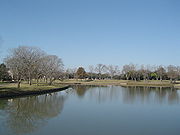.gif)
Hazard (golf)
Encyclopedia
A hazard is an area of a golf course
in the sport of golf
which provides a difficult obstacle. which may be of three types: (1) water hazards such as lakes and rivers; (2) man-made hazards such as bunkers; and (3) natural hazards such as dense vegetation. Special rules apply to playing balls that fall in a hazard. For example, a player may not touch the ground with his club before playing a ball, not even for a practice swing. A ball in any hazard may be played as it lies without penalty. If it cannot be played from the hazard, the ball may be hit from another location, generally with a penalty of one stroke. The Rules of Golf
govern exactly from where the ball may be played outside a hazard. Bunkers (or sand traps) are shallow pits filled with sand and generally incorporating a raised lip or barrier, from which the ball is more difficult to play than from grass.
 A bunker is a depression near the green or fairway that is usually filled with sand
A bunker is a depression near the green or fairway that is usually filled with sand
. It is difficult to hit the ball out of the bunker and entering it is therefore considered punitive to a golfer who misses the target with the previous shot. A club called a "sand wedge
" is designed for extracting the ball from a bunker, a process requiring well-developed skill. After a player is done using the bunker, it is the job of either the player or that player's caddy
to rake the area of the sand disturbed during play. Specific rules of golf
govern play from a bunker. For example, a player may not ground one's club in a bunker; that is, the club cannot touch the ground prior to the swing.
architecture and all are designed to be impediments to the golfer's progress toward the green. Fairway bunkers are designed primarily to gather up wayward tee shots on par 4 and par 5 holes; they are located to the sides of the fairway or even in the middle of the fairway. Greenside bunkers are designed to collect wayward approach shots on long holes and tee shots on par 3 holes; they are located near and around the green. Waste bunkers are natural sandy areas, usually very large and often found on links
courses; they are not considered hazards according to the rules of golf, and so, unlike in fairway or greenside bunkers, golfers are permitted to ground a club lightly in, or remove loose impediments from, the area around the ball.
course. Water hazards are typically either streams or ponds, situated between the teeing ground
and the hole.
 Two types of water hazards exist: "lateral" water hazards (marked with red stakes around the perimeter of the hazard) and water hazards (marked with yellow stakes). Lateral hazards are usually adjacent to the fairway being played (along the side), while water hazards generally cross the fairway being played forcing the player to hit over the water hazard.
Two types of water hazards exist: "lateral" water hazards (marked with red stakes around the perimeter of the hazard) and water hazards (marked with yellow stakes). Lateral hazards are usually adjacent to the fairway being played (along the side), while water hazards generally cross the fairway being played forcing the player to hit over the water hazard.
The only option that does not include a penalty stroke is:
1) playing the ball as it lies (without grounding his or her club) in the hazard;
All other options include one penalty stroke, BUT knowing these options may prove to favor the player:
2)playing a ball from the spot originating the shot hit into the hazard [called 'stroke and distance'];
3)dropping a ball along the 'line-of-flight' (using the pin and point where ball first crossed the hazard anywhere along that line away from the green) [often player may not be be able to get to that side of the hazard or that option may be out of bounds or a wooded area--or if the hazard is a lake this option may put you on the fairway across from the green!]
Two (2) other options are allowed when a ball is hit into a lateral(RED stake only) water hazard:
4)dropping a ball within two club lengths of the point where the ball last crossed the margin of the hazard (no closer to the hole);
5)dropping a ball within two club lengths of the point ACROSS THE HAZARD FROM where the ball last crossed the margin of the hazard (no closer to the hole);
Golf course
A golf course comprises a series of holes, each consisting of a teeing ground, fairway, rough and other hazards, and a green with a flagstick and cup, all designed for the game of golf. A standard round of golf consists of playing 18 holes, thus most golf courses have this number of holes...
in the sport of golf
Golf
Golf is a precision club and ball sport, in which competing players use many types of clubs to hit balls into a series of holes on a golf course using the fewest number of strokes....
which provides a difficult obstacle. which may be of three types: (1) water hazards such as lakes and rivers; (2) man-made hazards such as bunkers; and (3) natural hazards such as dense vegetation. Special rules apply to playing balls that fall in a hazard. For example, a player may not touch the ground with his club before playing a ball, not even for a practice swing. A ball in any hazard may be played as it lies without penalty. If it cannot be played from the hazard, the ball may be hit from another location, generally with a penalty of one stroke. The Rules of Golf
Rules of golf
The rules of golf are a standard set of regulations and procedures by which the sport of golf should be played. They are jointly written and administered by the R&A the governing body of golf worldwide except in the United States and Mexico, which are the responsibility of the United States Golf...
govern exactly from where the ball may be played outside a hazard. Bunkers (or sand traps) are shallow pits filled with sand and generally incorporating a raised lip or barrier, from which the ball is more difficult to play than from grass.
Bunker

Sand
Sand is a naturally occurring granular material composed of finely divided rock and mineral particles.The composition of sand is highly variable, depending on the local rock sources and conditions, but the most common constituent of sand in inland continental settings and non-tropical coastal...
. It is difficult to hit the ball out of the bunker and entering it is therefore considered punitive to a golfer who misses the target with the previous shot. A club called a "sand wedge
Sand wedge
An open faced club, sand wedge, or sand iron, is a wedge primarily designed for use out of sand bunkers. It has the widest sole of any wedge, which provides the greatest amount of bounce, allowing the club head to glide through sand and avoid digging in.-History:Gene Sarazen began to win...
" is designed for extracting the ball from a bunker, a process requiring well-developed skill. After a player is done using the bunker, it is the job of either the player or that player's caddy
Caddy
In golf, a caddy is the person who carries a player's bag and clubs, and gives insightful advice and moral support. A good caddy is aware of the challenges and obstacles of the golf course being played, along with the best strategy in playing it. This includes knowing overall yardage, pin...
to rake the area of the sand disturbed during play. Specific rules of golf
Rules of golf
The rules of golf are a standard set of regulations and procedures by which the sport of golf should be played. They are jointly written and administered by the R&A the governing body of golf worldwide except in the United States and Mexico, which are the responsibility of the United States Golf...
govern play from a bunker. For example, a player may not ground one's club in a bunker; that is, the club cannot touch the ground prior to the swing.
Types of Bunkers
There are three types of bunkers used in golf courseGolf course
A golf course comprises a series of holes, each consisting of a teeing ground, fairway, rough and other hazards, and a green with a flagstick and cup, all designed for the game of golf. A standard round of golf consists of playing 18 holes, thus most golf courses have this number of holes...
architecture and all are designed to be impediments to the golfer's progress toward the green. Fairway bunkers are designed primarily to gather up wayward tee shots on par 4 and par 5 holes; they are located to the sides of the fairway or even in the middle of the fairway. Greenside bunkers are designed to collect wayward approach shots on long holes and tee shots on par 3 holes; they are located near and around the green. Waste bunkers are natural sandy areas, usually very large and often found on links
Links (golf)
A links is the oldest style of golf course, first developed in Scotland. The word "links" comes from the Scots language and refers to an area of coastal sand dunes and sometimes to open parkland. It also retains this more general meaning in the Scottish English dialect...
courses; they are not considered hazards according to the rules of golf, and so, unlike in fairway or greenside bunkers, golfers are permitted to ground a club lightly in, or remove loose impediments from, the area around the ball.
Water hazard
Water hazards, like bunkers, are natural obstacles designed to add both beauty and difficulty to a golfGolf
Golf is a precision club and ball sport, in which competing players use many types of clubs to hit balls into a series of holes on a golf course using the fewest number of strokes....
course. Water hazards are typically either streams or ponds, situated between the teeing ground
Tee
A tee is a stand used to support a stationary ball so that the player can strike it, particularly in golf, tee ball, American football, and rugby.- Etymology :...
and the hole.
Types of Water Hazards

Rules
When a ball is hit into either type of hazard, the player has the following 3 options (for red AND yellow stakes):The only option that does not include a penalty stroke is:
1) playing the ball as it lies (without grounding his or her club) in the hazard;
All other options include one penalty stroke, BUT knowing these options may prove to favor the player:
2)playing a ball from the spot originating the shot hit into the hazard [called 'stroke and distance'];
3)dropping a ball along the 'line-of-flight' (using the pin and point where ball first crossed the hazard anywhere along that line away from the green) [often player may not be be able to get to that side of the hazard or that option may be out of bounds or a wooded area--or if the hazard is a lake this option may put you on the fairway across from the green!]
Two (2) other options are allowed when a ball is hit into a lateral(RED stake only) water hazard:
4)dropping a ball within two club lengths of the point where the ball last crossed the margin of the hazard (no closer to the hole);
5)dropping a ball within two club lengths of the point ACROSS THE HAZARD FROM where the ball last crossed the margin of the hazard (no closer to the hole);

